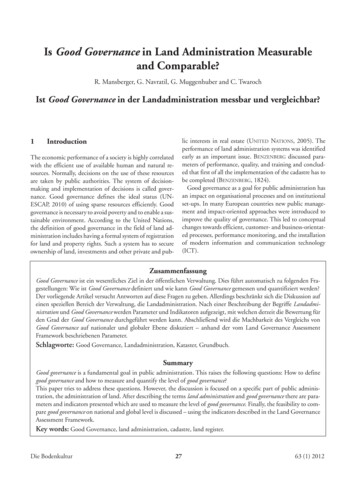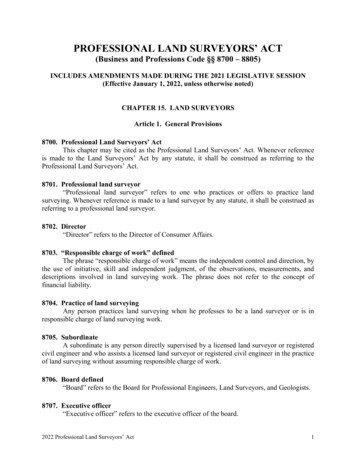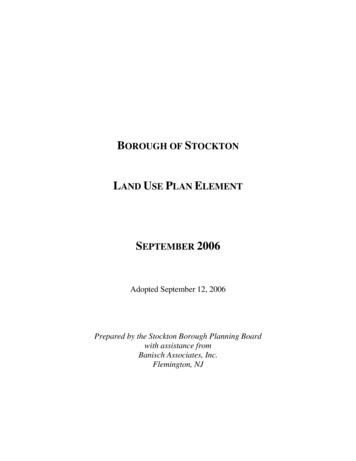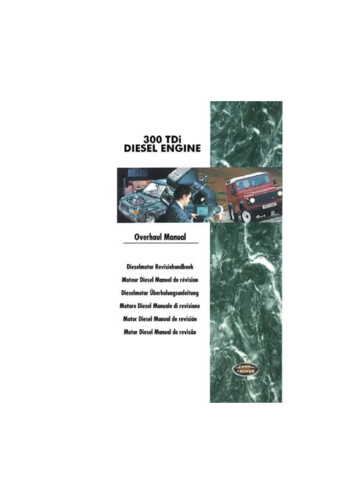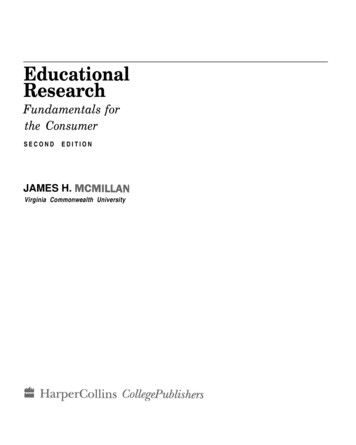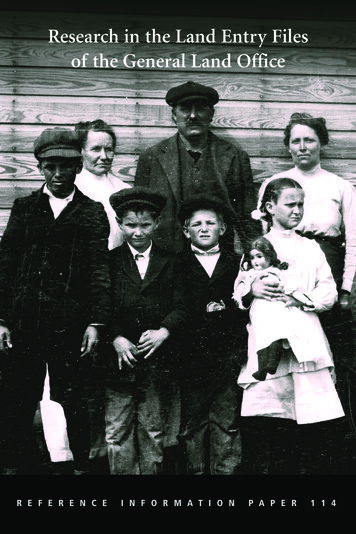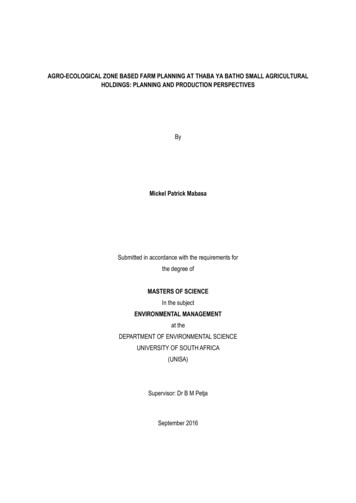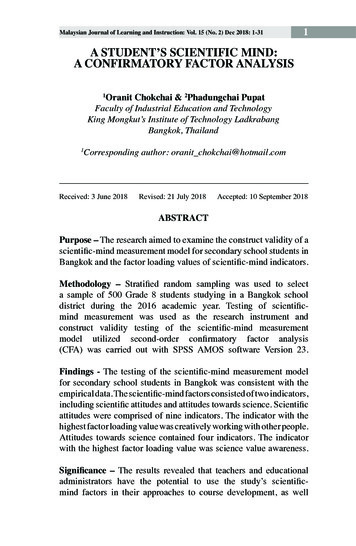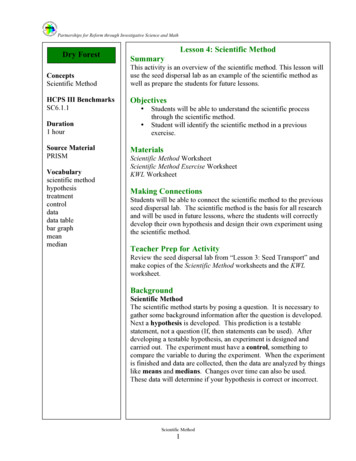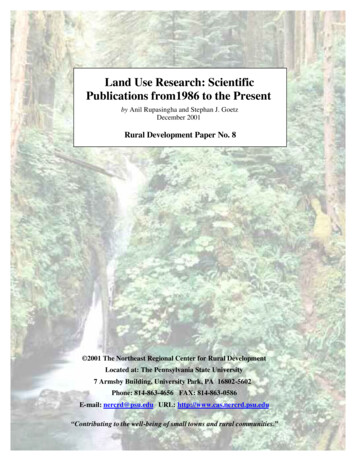
Transcription
Land Use Research: ScientificPublications from1986 to the Presentby Anil Rupasingha and Stephan J. GoetzDecember 2001Rural Development Paper No. 8 2001 The Northeast Regional Center for Rural DevelopmentLocated at: The Pennsylvania State University7 Armsby Building, University Park, PA 16802 -5602Phone: 814-863-4656 FAX: 814-863-0586E-mail: nercrd@psu.edu URL: http://www.cas.nercrd.psu.edu“Contributing to the well-being of small towns and rural communities.”
Land Use Research:Scientific Publicationsfrom 1986 to the PresentDraft 2001The Northeast Regional Association of Agricultural Experiment StationDirectors and The Northeast Regional Center for Rural DevelopmentNERCRD RDP No. 8Draft v. 1.0, August 8, 2001, revised December 2001REPORT -front2.doc
Table of ContentsIntroductionAbstracts of Papers1. Sprawl2. Smart Growth3. Transportation and Congestion4. Regulation and Zoning5. Transferable Development Rights6. Agricultural Land Use and Farmland Preservation7. Conservatio n Reserve Program (CRP)8. Environment and Sustainability9. Biodiversity10. Housing11. Recreation12. Economic Growth13. General (not elsewhere classified) and MethodologyBibliographyRupasingha and Goetz: Land Use Research, page 2
Land Use Research: Scientific Publications from 1986to the PresentAnil Rupasingha and Stephan J. GoetzABSTRACT. We present a collection of over 300 studies on the subject of land use completed since 1986.Most of these studies appear in peer-reviewed journals. The studies are primarily drawn from economics,agricultural economics, and regional science with a smaller number selected from other social sciences.The studies were grouped into 13 areas. A short overview introduces the reader to the primary questionsand issues addressed in these studies.INTRODUCTIONGrowing problems attributed to housing sprawl, including traffic congestion, pollutionand related issues have heightened policy makers’ concern over land use patterns, landvalues and land use planning. The concern stems from the belief that uncoordinated development, in the form of sprawl, is no longer in the long-term interest of local communities and their environments. There is also a growing sense of urgency because of the realization that these new uses of land are largely irreversible. Although growth in thestock of housing is necessary to accommodate increasing population numbers and technological change, communities are questioning the economic and social costs of unchecked expansion of suburbs, abandonment of efforts to improve central cities, use ofopen space and prime agricultural lands at the edge of suburbs, destruction of localamenities and habitats, and pollution of air and water resources.Economists traditionally consider land to be a factor of production, along with capital andlabor. Even though land has been considered in this manner, mainstream economics hasin recent years for the most part ignored the contribution of land to economic growth.One reason for this is that economies have become increasingly dependent on servicesover time. Interest in this topic has now reemerged, and we treat the role of land in economic growth in a separate section in the literature synopsis below. Lately, economistshave also started to collaborate with other disciplines in studying land use patterns, andincreasingly also view land as a consumption good with an amenity value.Land use patterns in the United States are the result of sustained economic growth coupled with improvements in transportation infrastructure, advances in the automobile industry and other types of technological change. Expanded road networks and affordableautomobiles complemented with supportive policies (incentives) have encouraged suburban expansion. Today, many Americans live and work in the suburbs. Suburban areasprovide mo re space, bigger and better housing, good schools, better recreational opportunities and amenities, and more convenient shopping. As a result, central city centers havebecome less attractive for businesses and residents. Residents who still hold jobs in central cities also choose to live in the suburbs and commute daily, benefiting from improvedtransportation networks and affordable automobiles.Rupasingha and Goetz: Land Use Research, page 1
However, uncontrolled land use in the suburbs is facing growing opposition because ofthe associated problems. Increasing traffic congestion is directly connected with sprawl,raising pressure on transportation needs and infrastructure development. Researchers areonly beginning to understand potential effects on human health of the resulting air pollution. The decline and degradation of city centers is a direct result of residents’ and bus inesses’ preference for locating in the suburbs. A related phenomenon is the spatial mismatch problem, whereby sub-urbanization of low-skill jobs and housing market discrimination are primarily responsible for growing employment problems in the inner citieswhere most minorities live. Opponents of sprawl also claim that unchecked developmenthas significant adverse effects on environmental quality, including habitat and biodiversity. Another argument is that the supply of farmland is declining due to sprawl, andfarmland preservation programs have been implemented to protect farmland from beingconverted to non-agricultural uses.Rules and regulations in the form of ho using caps, zoning restrictions, limitations on theamount of developable land, and other forms of growth controls have been introduced tocontain some of these problems. These growth controls may reduce adverse externalitiesassociated with growth. On the other hand, restrictions on the development of land,along with improved environmental conditions and limited supplies drive up land pricesand housing costs, putting the “American Dream” out of reach of lower- income families.The catchword of “smart growth” has come to the fore as a solution to the problems arising from urban sprawl. However, this concept has also been referred to as “unconstitutional and un-American”. 1 The objective of smart growth is to minimize the adverse effects of population flight on older downtowns and neighborhoods, preserve the community character and the countryside, and mitigate the high concentration of poverty andsocial problems in inner cities.In summary, current land use issues involve consumers’ trade-off between the benefits ofliving in low-density housing developments and the costs associated with sprawl such asincreasing traffic congestion (Goetz 2001). 2 Often, the decision that is rational for ind ividuals has consequences in the aggregate that are undesirable to society. The problemsassociated with housing sprawl are not new (for a historical perspective, see Rome2001).3This preamble only scratches the surface of how land use affects and is affected by various aspects of human activity and environment. Yet, comprehensive compilations of literature related to this important subject are relatively rare, perhaps because the subject isvast and multi-dimensional. This evolving bibliography is one step towards rectifyingthis situation.1Mary Meehan, Lexington Herald Leader, August 13, 2001.Goetz, Stephan J. “Land Use Issues and Research Opportunities in the US.” Paper presented at the second annual conference on European and U.S. Partnerships in Food and Agriculture Education and Research, April 4 and 5, 2001, Freising-Weihenstephan, Technical University of Munich, Ge rmany.3Rome, Adam. The Bulldozer in the Countryside: Suburban Sprawl and the Rise of American Environmentalism. Cambridge, UK; Cambridge University Press, 2001.2Rupasingha and Goetz: Land Use Research, page 2
ORGANIZATION OF THE BIBLIOGRAPHYWe have selected the following categories to group the various studies in this report:1. Sprawl2. Smart Growth3. Transportation and Congestion4. Regulation and Zoning5. Transferable Development Rights6. Agricultural Land Use and Farmland Preservation7. Conservation Reserve Program (CRP)8. Environment and Sustainability9. Biodiversity10. Housing11. Recreation12. Economic Growth13. General (not elsewhere classified) and MethodologyThese categories are not necessarily mutually exclusive. Studies that clearly do not fallinto any of these categories have been grouped into the last section as General. Readerswho are looking for a particular author may use the list of references at the end of the report. A brief summary of the various sections is presented below.1. SprawlSprawl causes or contributes to traffic congestion, air pollution, large-scale absorption ofopen space, infrastructure and facility problems, shortages of affordable housing nearwhere new jobs are being created, and suburban labor shortages. Urban sprawl has beenencouraged by subsidized development of the highway transportation system as well asother types of technological change. Policies such as mortgage interest rate deductionsare also argued to contribute to sprawl. Migration of shopping complexes, jobs and industries, and entertainment industry from the central cities to suburbia is a major forcecreating this land use pattern. Residential patterns have also been transformed with thisland use pattern. Residents’ preference for single- family detached housing and their desire to live closer to shopping complexes, jobs, and schools define the other aspects ofsprawl. As this transformation continues, conditions in city centers deteriorate further.Sprawl also has many benefits, which include low-density residential lifestyles, easy access to open space at home and in the country, relatively short commuting times for thosewho both live and work in the suburbs, ease of movement, and the ability to separate oneself spatially from problems associated with poverty and the inner city. Newer homesalso require less maintenance, at least initially; as the opportunity cost of time increases,this may be an increasingly important consideration. A recently released study points outRupasingha and Goetz: Land Use Research, page 3
that the homes built in the first wave of suburbanization are starting to deteriorate andbecome less desirable (Lucy and Phillips 2001). 4On the other hand, some argue that the benefits of sprawl to society outweigh the costs.Sprawl at the fringe of urban centers has become a major cause of environmental pollution, and sprawl reduces quality of life by contributing to congestion and raising pollutionlevels. The result of this may be that residents move out and fewer new residents movein. Other disadva ntages include traffic congestion, loss of open space and agriculturalland, deterioration of urban centers, and social impacts such as spatial mismatch of workers and jobs.Most of the studies conducted over the last fifteenyears focus on causes ordeterminants of sprawl,measurement and modelingof environmental impactsof sprawl, managing of urban growth and curbingsprawl, effects of sprawl onsocial and civic ties, impacts of sprawl on housingprices and affordability,sprawl and traffic congestion, federal role in sprawl,and impacts of sprawl onhuman geography. Studiesthat focus on the consequences of sprawl find that sprawl leads to higher monetary, social, and environmental costs. For a comprehensive recent review, see Heimlich andAnderson (2001). 5One issue that has been discussed at length is that sprawl generates poverty in inner citiesand concentrates the poor or poor minorities in city centers. Sprawl is also criticized asweakening neighborhood social bonds and the literature points to the heavy dependenceon automobiles resulting from sprawl as a major cause of this deterioration, because itreduces contact with neighbors. The policy prescriptions that have been proposed to dealwith problems related to sprawl are to shift more resources, including investment, towardsolving poverty and housing problem in central cities, and creation of more opportunitiesand affordable housing in the suburbs for low income minorities. A few studies point tothe positive aspects of sprawl. One reports that sprawl has increased the affordability ofhousing and narrowed the homeownership gap between Blacks and Whites.Maps showing rates of land conversion over various time periods are available at:4Lucy, W.H. and D.L. Phillips, “Suburban Decline: The Next Urban Heimlich, Ralph E. and William D. Anderson, Development at the Urban Fringe and Beyond. USDA,ERS Agricultural Economic Report No. 803, June 2001.Rupasingha and Goetz: Land Use Research, page 4
html (from the 1997 National Resource Inventory).2. Smart GrowthSmart growth has come to the fore as a solution to the problems arising from sprawl.Smart growth seeks to create vibrant, sustainable and livable communities through intelligent planning and effective use of resources. The objectives of smart growth are tominimize the adverse effects of sprawl on older downtowns and neighborhoods, preservecommunity character and the countryside, and reduce the high concentration of povertyand social problems in inner cities. The literature on smart growth explains what smartgrowth is, its effect on housing and property prices, and how it relates to federal and localgovernment policy on smart growth.The literature also focuses on ways in which housing development can be used to implement better smart growth policies. The most widely discussed smart growth issues, especially in the popular press, include market issues such as financial barriers, governmentsubsidies, and consumer preferences for low-density housing. Some studies solely focuson the benefits of smart growth while others focus on barriers to smart growth includingcommitment from policy makers. Studies also propose strategies for smart growth basedon “planning for sustainability.” As suggested in the introduction, opponents of smartgrowth are as vociferous as the proponents, and a considerable need exists for precisedefinitions, measurement and information in this area.3. Transportation and CongestionTransportation planning and growth management have become priorities for many stateand local officials. It has been argued that sprawl is an unwanted byproduct of the Interstate Highway System. There is growing recognition that land use and transportationplanning policies must be closely coordinated in order to adapt transportation networks tochanging patterns of development in a region. Most studies in this area develop modelsof land use and transport interaction. Other studies consider alternative transport systemsto overcome land use problems, transportation as a constraint to land development, relationship between land use and non-work related travel, impact of rail-transit on land market, and transit-focused land development. However, researchers point out that the political will is rarely strong enough to implement such policies.A topic related to transportation is that of congestion. Increasing traffic congestion isalso directly connected with sprawl. The literature includes models that deal with congestion and land use planning, issues related to congestion, employment and land use,policy analyses, congestion in suburbs, and effects of congestion tolls. Some studies focus on modeling ways to reduce traffic congestion in urban areas.Rupasingha and Goetz: Land Use Research, page 5
Related websites, data sets and studies are available from the Texas Transportation Institute (2001 Urban Mobility Study: http://mobility.tamu.edu/) and the Federal HighwayAdministration.Office of Highway Policy Information: http://www.fhwa.dot.gov/ohim/4. Regulation and ZoningLand use regulation and zoning are among themost acrimonious and contentious areas of localgovernment policy. On the one hand, housingcaps, zoning restrictions, limitations on theamount of developable land, and other forms ofgrowth controls restrict the supply of housingand land over time and cause shifts in the housing and land supply curves, and housing costincreases. At the same time, growth controls reduce negative externalities associatedwith growth, and shift the demand curve outward, also driving up prices. Economic theory therefore predicts that regulations affect housing market outcomes both by constraining supply and increasing demand.There is a considerable body of research on the theoretical and empirical effects of landuse regulations on urban form, development patterns and the price of housing. Most ofthe existing empirical studies have investigated the impact of regulation on house prices,with the majority finding that regulation leads to higher house prices.Zoning has been credited as being an effective way of overcoming some of the negativeexternalities associated with having commercial and manufacturing establishments inresidential areas. Most of the studies investigate the effect of suburban zoning on landand housing prices and find that zoning restrictions significantly increase the value of existing homes. A few studies find that restric tive agricultural zoning increases the value ofagricultural land. Others find that the value of undeveloped land falls when stricter zoning ordinances are implemented.5. Transferable Development RightsTransferable Development Rights (TDRs) allow land planners to overcome many of theshortcomings associated with traditional zoning practices. These rights work by designating a sending zone in which development is restricted, and the development right is“transferred” to a receiving zone. Receiving zones are areas in which development ispermitted with the purchase of development rights (TDRs) from a sending zone.The value of TDRs is market-determined. TDRs can have many positive land management impacts, but must be developed within the constitutional constraints of the FifthAmendment's takings clause. Issues examined in the literature include TDRs’ effectiveness in preserving agricultural land, importance of municipal monopoly power on deci-Rupasingha and Goetz: Land Use Research, page 6
sions about TDRs, public support for TDRs, and effectiveness of the TDR program incomparison to zoning and other regulations.6. Agricultural Land Use and Farmland PreservationThe literature on agricultural land use is multifaceted. In earlier studies (late 1980s),conversion of land for crop production in the presence of crop surpluses was of particularinterest. Sections of the literature in this area discuss impacts of agricultural price supports and other production control programs on agricultural land values and prices. Theliterature also focuses on conservation and land prices, effects of urbanization on agricultural land, diversification of agricultural land use, determinants of agricultural land use,conversion of farmland to rural residences, determinants of conversion of crop productionto pasture, and the influence of future land development on current agricultural land values.Farmland preservation is aimed at protecting farmland from conversion to nonagriculturaluses. Most of the literature in the area of farmland preservation is based on adverse effects that a decliningamount of farmland mayhave on the nation’s capacity to produce food andfiber. The underlyingtheme is that the supply offarmland is declining at thesame time that the demandfor agricultural products isincreasing. However,studies generally concludethat the nation’s foodsupply is not at risk fromland conversion, although the production of some crops may be affected. Another argument is that conversion threatens the rural way of life, open space, and environmentalquality. Other reasons for farmland preservation, especially at the urban fringe, includeprotecting land for specialty crops and providing certain public goods, such as flood absorption, air cleansing and water filtration. Scho lars have also developed tools to forecastconversion rates and amounts of farmlands subject to the influences of sprawl.7. The Conservation Reserve Program (CRP)The CRP is a federal program that was designed to control the supply of agricultural production, conserve land and boost commodity prices by limiting the supply of land available for production. The CRP gives farmers who agree to retire their highly erodible landfor 10 years an annual rental payment and half the cost of establishing a permanent cover.It is also considered to be one of the largest environmental improvement programs by theRupasingha and Goetz: Land Use Research, page 7
federal government because it helps prevent soil erosion, increases wildlife habitat, andprotects ground and surface water.Agricultural economists and environmental economists have conducted various studies of the CRP.Researchers have argued that thevalue of enrolled land would increase because farmers would receive a CRP rent that is considerablyhigher than could otherwise beearned. The value of the nonenrolled land may also go up due toimprovements in water quality associated with the CRP. Another areaof research is the economic impact ofthe program on rural agriculturalcommunities. Studies have found that some agriculturally-dependent communities havebeen adversely affected. Among other studies, the impact of CRP on non-point sourcepollution, its impact on the structure of farming, and factors affecting landowners' postcontract use of CRP lands are important.URL for map: ap109.htm8. Environment and Sustainability; Valuation of LandLand use planning and decisions have enormous impacts on the environment. At thesame time, the quality of the environment has a substantial impact on the (amenity) valueof land. Issues addressed in the literature are diverse in this area. Among them are: theeffects of integrating federal environmental programs with local land use planning entities to improve environmental decision making, effects of water quality on residentialland prices, attitudinal studies of land use and environmental quality, development, andenvironmental issues in communities, valuing wetlands, land use planning and groundand surface water quality, land use planning and waste management, impacts of land useregulatory policy on environmental quality, impacts of agricultural pollution on land va lues, superfund sites and land values, effects of environmental regulation on land prices,and use of improved production practices to improve the qua lity of land and environment.[Discussion in WTO]9. BiodiversityLand use decisions have become controversial mainly because their prospective impacton biodiversity. Sustainable development and smart growth call for greater respect fornatural systems. Although it is an important aspect in land use planning, the relationshipbetween land use planning and biodiversity has not received much attention in the litera-Rupasingha and Goetz: Land Use Research, page 8
ture. We were able to locate only a handful of studies from the major databases. Most ofthese studies focus on modeling ecosystem and landscape structures. One study modelthe regenerative capacity of forests as a function of the own forest stock, deforestation foragricultural purposes, and habitat size and develop a biodiversity sustainability index.Other literature focus on biodiversity as a primary land use pattern and its economicbenefits, wetlands and land use, and practices of biodiversity management among varioussocial groups.10. HousingRapid growth patterns over the years have had enormous impacts on affordable housingin inner cities and suburbs for low- income families. Home ownership is still a dream formany low-to-middle- income families and minorities, however. The relationship betweenhousing and land use is a relatively under-researched area. Most of the papers that dealwith housing and land use examine the effect of land use regulations and restrictions onhousing prices, and these papers are listed in the section on regulations and zoning.Several papers discuss the relationship between land-use planning and the supply andprice of housing. Among the other issues that have received attention in this area are:demographic and socio-economic impact of free-standing new settlements; physical decay of housing stocks in urban areas and their impact on housing markets; changing landand housing market in East European countries; controlling land prices and housing market in the United Kingdom; new communities and land usage in Florida; and suburbanclusters and medium-density residential development.11. RecreationRecreation-oriented tourism is viewed in many nations as an environmentally friendlyway to revitalize distressed rural economies and communities. Nature-based tourism hasbeen considered as a sustainable rural development strategy in regions where most land isheld privately. Efforts have been made to increase the quantity and quality of wildlifehabitat associated with U.S. agricultural lands implying that society would benefit iffarmers and ranchers allocated more land and water resources to wild species.Existing papers on this subject discuss various issues including recreational huntingleases to agricultural land investors, comparisons of various user groups about recreational rates and future land use preferences for a particular site, policy considerations forincreasing compatibilities between agricultural land use and wildlife, and potentials andpitfalls of nature tourism.Rupasingha and Goetz: Land Use Research, page 9
12. Economic GrowthAs indicated earlier, the relations hip between land as a factor of production and its relationship to economic growth has not received much attention in the economic growth literature until very recently. Instead, the mainstream economic growth literature focusesmainly on physical (man-made) capital, human capital and their relationship to economicgrowth. This is changing as scholars increasingly concentrate on the effect of naturalcapital on economic growth.13. General and MethodologyStudies that deal with developing various research tools and models to study and evaluateland use issues are included in this category. These studies include: the use of GIS tomodel land use allocation and spatial forecasts for various types of land use; econometricmodels to study the impact of la nd use changes on environment, use of satellite images ineconometric analysis of land use, spatial interaction land-use modeling, and othereconometric issues in land use models; use of referendum methods to decide best landuse patterns; and development of planning models to help planners, policy makers, andcitizen groups compare alternative land- use policies.Rupasingha and Goetz: Land Use Research, page 10
1. SPRAWLJohnson, M.P. "Environmental Impacts of Urban Sprawl: A Survey of the Literature and ProposedResearch Agenda." Environment and Planning A 33(2001):717-35.AB. 'Urban sprawl' has recently become a subject of popular debate and policy initiatives fromgovernmental bodies and nonprofit organizations. However, there is little agreement on many aspects ofthis phenomenon: its definition, its impacts-both nonmonetary acid monetary-economic and policy modelsthat predict the presence of sprawl, and decision-support models that could assist policymakers inevaluating alternative development schemes that may have characteristics of sprawl. In particular, there isrelatively little research on urban sprawl that focuses specifically on measurement and modeling ofenvironmental impacts. The purpose of this paper is twofold: to survey the literature on urban sprawl, witha focus on environmental aspects and to identify a research agenda that might result in a greater number ofanalytical tools for academics and practitioners to characterize, monetize, model, and make planningdecisions about sprawl.Kahn, M.E. "City Quality-of Life Dynamics: Measuring the Costs of Growth." Journal of RealEstate Finance and Economics 22(2001):339-52.AB. Two continuing California trends are population growth and improving air quality. Sprawl at thefringe of metropolitan areas may lower quality of life by contributing to congestion, reducing open spaceand raising pollution levels. This article studies this claim by estimating hedonic wage and rentalregressions using California 1980 and 1990 micro census data. Real rents have fallen in faster-growingareas, suggesting that the "growth causes degradation" hypothesis has some merit. Sprawl's damage to localquality of life would be higher if fringe growth degrades air quality and households greatly value avoidingpolluted areas. The relative importance of air quality as an urban amenity is tested using data from LosAngeles county, an area where dramatic improvements in smog have taken place. While high-ozone areasfeature lower rents, the ozone's capitalization suggests that it is not a key urban disamenity.Kahn, M.E. "Does Sprawl Reduce the Black/White. Housing Consumption Gap?" Housing PolicyDebate 12(2001):77-86.AB. Because unplanned suburban growth imposes social costs such as congestion, pollution, and reductionof open space, antisprawl policies are being adopted in fast-growing metropolitan areas. This articleexplores one potential benefit of sprawl: It increases housing affordability, which may contribute toreducing the black/white housing consumption gap. The article uses 1997 American Housing Survey datato measure housing consumption for blacks and whites in metropolitan areas characterized by mo re andless sprawl. In sprawled areas, black households consume larger units and are more likely to own theirhomes than black households living in less sprawled areas.Daniels, T.L. "Coordinating Opposite Approaches to Managing Urban Growth and Curbi ngSprawl: A Synthesis." American Journal of Economics and Sociology 60(2001):229-43.AB. The purchase of development rights to farmland and open space has recently gained in popularity as agrowth management tool. A purchase of development rights program pays the landowner
NERCRD RDP No. 8 Draft v. 1.0, August 8, 2001, revised December 2001 REPORT -front2.doc. Rupasingha and Goetz: Land Use Research, page 2 Table of Contents . Land Use Research: Scientific Publications from 1986 to the Present Anil Rupasingha and Stephan J. Goetz ABSTRACT. We present a collection of over 300 studies on the subject of land use .
